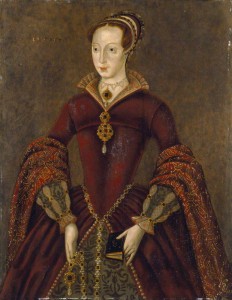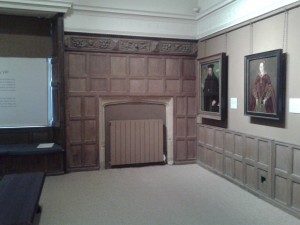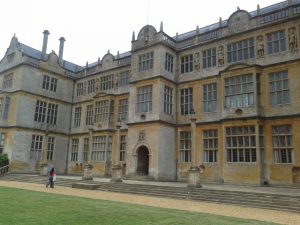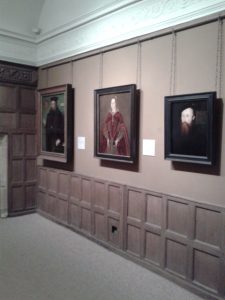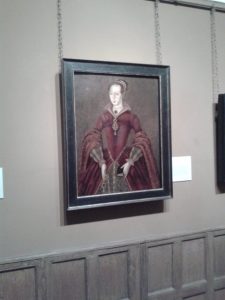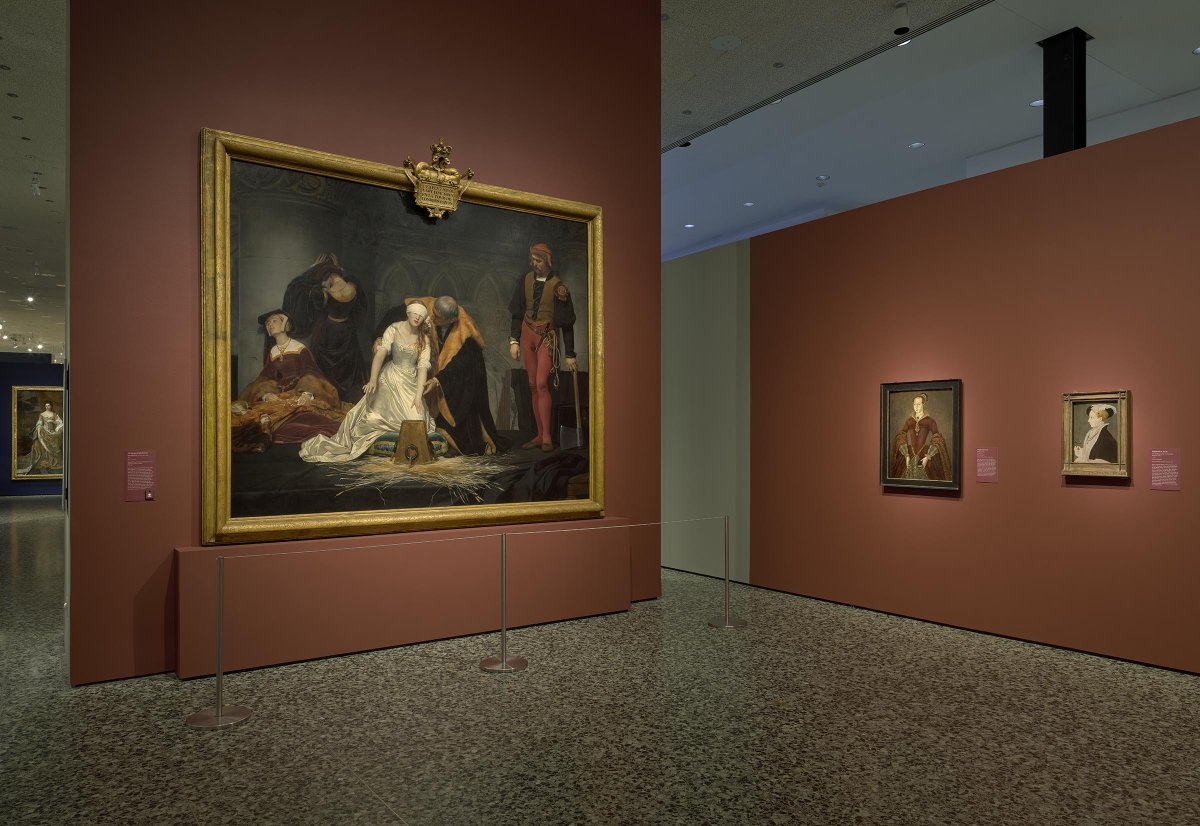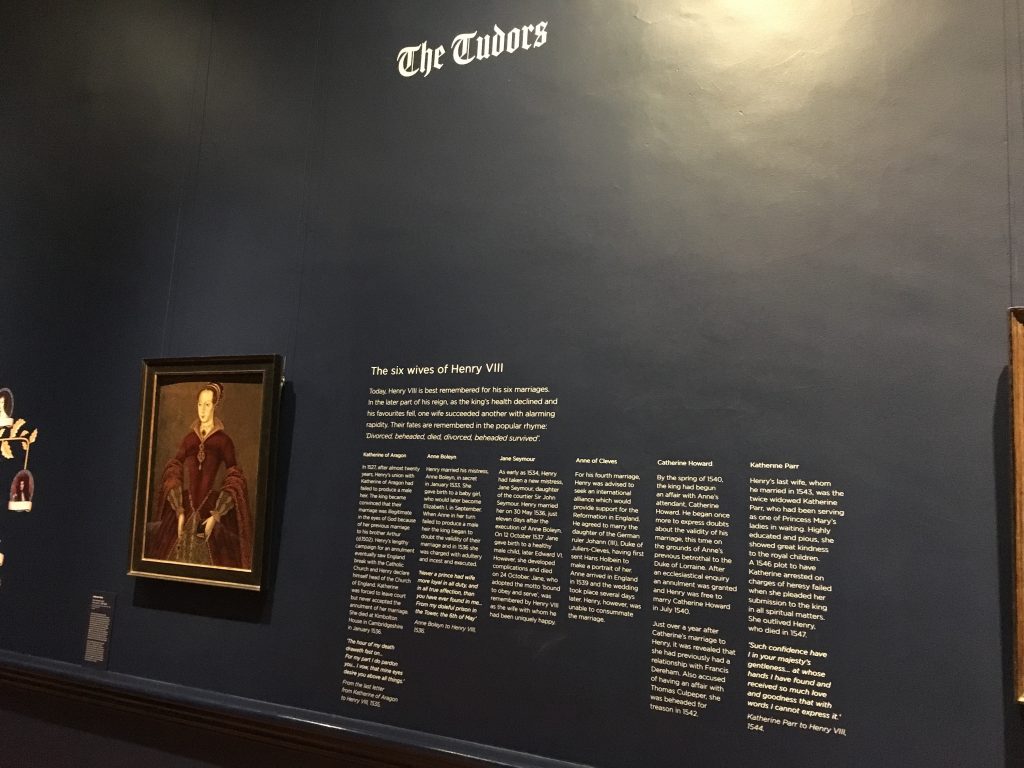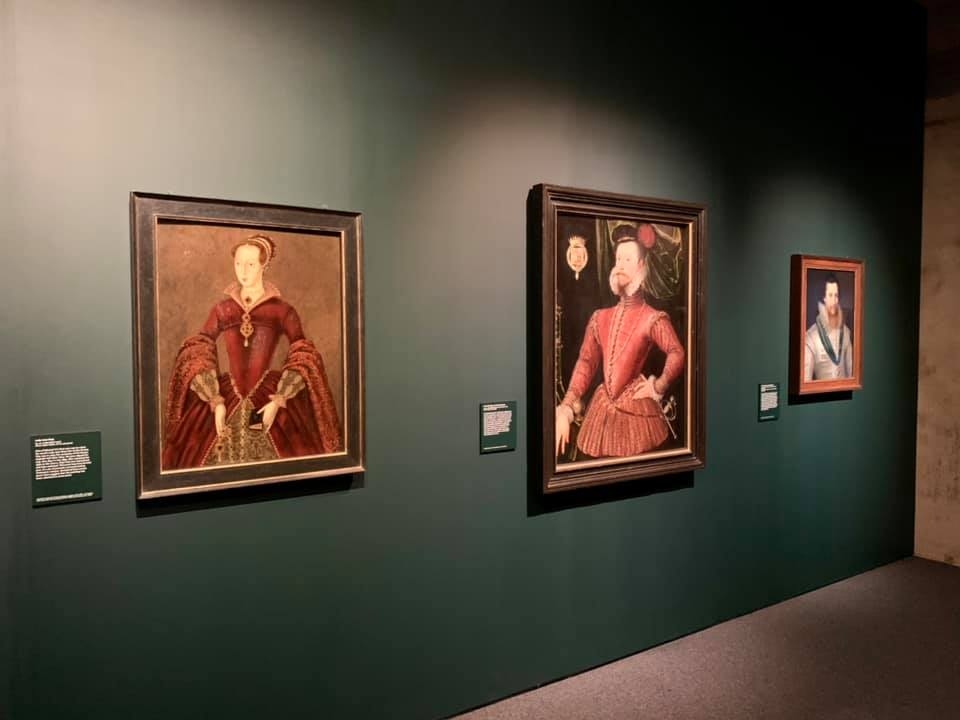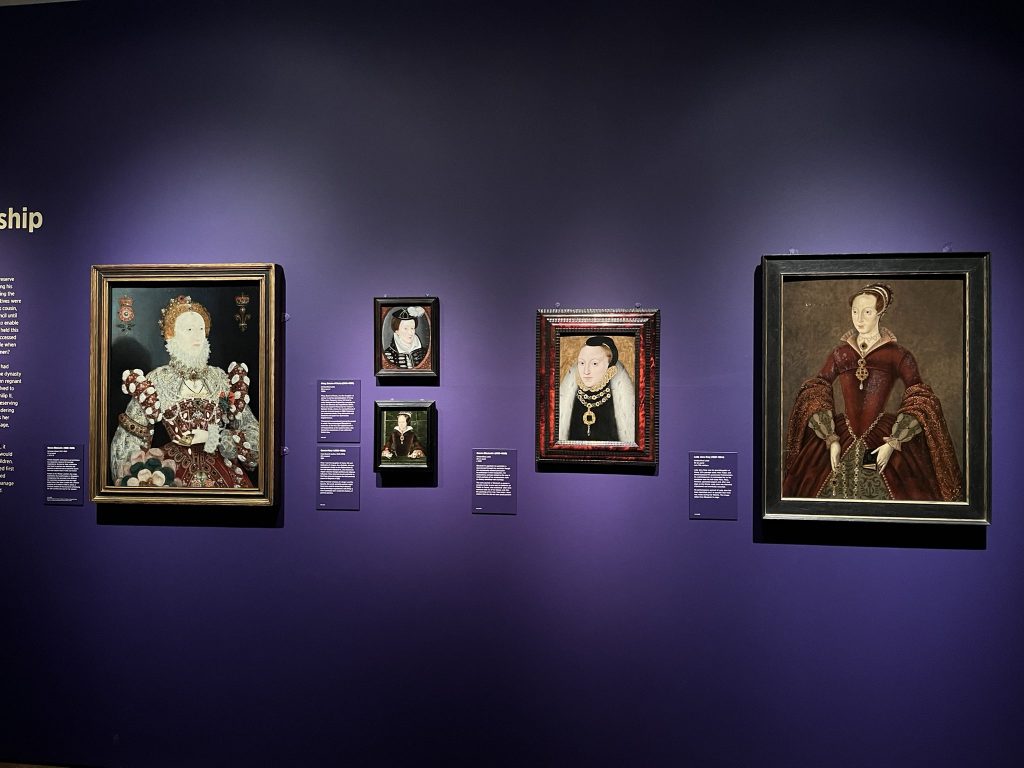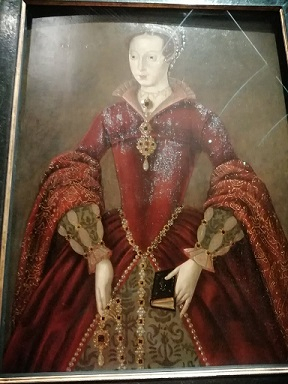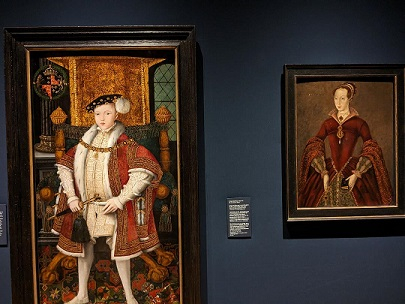The portrait was discovered at a house in Streatham in January 2006. It was announced in the November of that year, that it had been purchased by the National Portrait Gallery.
The portrait was first on display at the Gallery in Room 3 of the Tudor Galleries from spring 2007 to April 2009 and then at the entrance to the ‘Lady Jane Grey’ display from December 2009 until 15th August 2010. Between March 2013 and May 2014 it was on display at Montacute House in Somerset.
It was back in Room 3 at the National Portrait Gallery as part of ‘The Real Tudors: Kings & Queens Rediscovered’ exhibition from 12 September 2014 until 1st March 2015.
On March 23rd, the National Portrait Gallery posted a photo of the portrait being reframed as part of Museum Week.
Down in the Framing Studio, the team is reframing a portrait of Lady Jane Grey #secretsMW #MuseumWeek pic.twitter.com/7ew9VjLesQ
— Portrait Gallery (@NPGLondon) March 23, 2015
The portrait returned to Room 2 of Montacute House in the late spring of 2015.
From October 7th 2018 until 27th January 2019, the portrait was on display at the Museum of Fine Arts, Houston as part of the ‘Tudors to Windsors: British Royal Portraits from Holbein to Warhol’ exhibition.
From 16th March until 14th July 2019, was on display at the Bendigo Art Gallery, Australia as part of the ‘Tudors to Windsors: British Royal Portraits’ exhibition.
From 28th May until 31st October 2021 it was on display at the National Maritime Museum, Greenwich as part of the ‘Tudors to Windsors: British Royal Portraits’ exhibition.
From 28th January to 8th May 2022 it was on display at The Holburne Museum in Bath, as part of The Tudors: Passion, Power & Politics exhibition.
From 21st May to 29th August 2022, the portrait was on display at the Walker Art Gallery, Liverpool as part of The Tudors: Passion, Power & Politics exhibition.
The painting was the subject of a gallery talk by Justin Nolan on June 12th 2007.
These were the main points from this talk:
‘The NPG has been aware of this painting since 1923. It is a ¾ length portrait of a woman wearing high status clothing from the 1550s.
The sitter is someone of importance. Analysis (including ‘dendrochronology’) has shown that the wood used dates from after 1593. The question is why would someone paint a portrait of a woman after 1593 wearing clothing from forty years before? There must have been something about the sitter to make it worthwhile.
The inscription dates from the same time as the portrait and cross referencing it with the known ‘Lady Jayne’s’ at the time, shows that it could refer to Jane Grey.
Jane was in the public consciousness in 1602. This is shown by Thomas Dekker’s play, ‘Sir Thomas Wyatt’. Some of this play survives and in it, Jane and Guildford are portrayed as lovers. So from very early on, the romantic notion of Lady Jane Grey existed.
It is possible that this painting belonged in the collection of a gentleman who wanted to promote his enthusiasm for Protestantism and could have been part of a series of paintings of ‘Protestant Worthies.’
This was probably not intended to be an accurate portrait of Jane but was using her as a badge of the Elizabethan Protestant Order.’
There isn’t anything in this portrait that supports an accurate representation, however, the question remains, why else produce this painting’ (Justin Nolan, NPG)
The painting was displayed between 2007 and 2009 as:
‘Memorial Portrait of Lady Jane Grey (Lady Jayne)
Unknown
16th century’ (NPG)
The postcard on sale at the time had the following information:
‘Lady Jane Dudley (nee Grey) 1537-54
After a portrait by Hans Holbein the Younger.’ (NPG)
It was displayed between December 2009 and August 2010 as:
‘Unknown, 1590s
‘This panel is one of the earliest surviving portraits of England’s shortest reigning monarch Lady Jane Grey. It was not painted from life or indeed made during her lifetime. It is a commemorative portrait made at least 40 years after her death.’ (NPG)
It was displayed between March 2013 and May 2014 as:
‘Lady Jane Grey
By an unknown artist
Oil on oak panel 1590s’
‘This is one of the earliest surviving portraits of England’s shortest-reigning monarch, Lady Jane Grey, despite being made some 40 years after her death. The sixteen-year-old Jane Dudley (née Grey) was nominated by her cousin, Edward VI, to succeed him and at his death was uncrowned Queen of England for nine days before being deposed and executed by Mary I.
A commemorative portrait, this panel may have formed part of a set of Protestant martyrs. Scratched lines across the eyes and mouth suggest that the painting may have been subjected to an iconoclastic attack at some point in its history.’ (Montacute House)
At ‘The Real Tudors: Kings & Queens Rediscovered’ exhibition from 12 September 2014 to 1st March 2015 it was displayed as:
‘Lady Jane Grey
By an unknown artist
Oil on panel, late sixteenth century’ (NPG)
‘Lady Jane Grey was named as heir to the throne by her cousin Edward VI: however, she was imprisoned after only nine days’ rule when Mary successfully asserted her right to the crown. Highly educated and devoutly Protestant, it was only during Elizabeth’s reign that she became more widely known. This fuelled an interest in her portraiture and portraits such as this example were created to mark her place for an Elizabethan audience. However, no lifetime portraits of Jane appear to survive and it is possible that none were ever painted. By 1620, one image had gained credence as a lifetime portrait and was used as the basis for an engraving. However, the sitter in this image wears a jewel that is very similar to one that belonged to Katherine Parr, and may be Henry VIII’s sixth queen.’ (NPG)
In the catalogue to accompany the exhibition, it is stated that:
‘Even during the uncertain time between Edward’s death and Mary’s accession, Jane made little mark on contemporary commentators, and given the short period of her reign it is not likely that a portrait was ever produced.
…Numerous portraits have been identified as Jane, but no certain image during her lifetime appears to have survived, if one ever existed. One portrait thought to depict Jane was painted in the Elizabethan period and was probably produced in response to her growing reputation as a Protestant martyr. In this three-quarter-length image, she stands holding a book, wearing a costly, if simply painted, gown of red velvet and cloth-of-gold and silver. Tree-ring dating suggests that the portrait was painted in the 1590s, and thus it may derive from an earlier likeness, or could even have been adapted from a portrait of another sitter. Whatever the case, it is clear that the portrait served as a likeness of Jane for its Elizabethan audience. The fragmentary inscription, which identifies the sitter as ‘Lady Jayne’, suggests that it may have formed part of a set of portraits, and the scratched lines across the eyes and mouth may be result of a deliberate attack at some point in history.’ (1)
In May 2014, Dr Stephan Edwards published his latest findings on the portrait, at his website, Some Grey Matter. He wrote:
‘On the whole, it seems entirely likely that the Streatham Portrait was based upon some earlier reference image that depicted Katherine Parr but, like the Norris Portrait, was adapted to “become” Jane Grey in the absence of an accessible authentic portrait of Jane.’ (2)
In 2015, the portrait was included in his book ‘A Queen of a New Invention: Portraits of Lady Jane Grey Dudley, England’s ‘Nine Days Queen.’
It was displayed from late spring 2015 in Room 2 at Montacute House as:
‘Lady Jane Grey 1537 – 1554
By an unknown artist
Oil on oak panel, c.1590 – 1600’
‘This is one of the earliest surviving portraits of England’s shortest-reigning monarch, Lady Jane Grey, despite being made some forty years after her death. The sixteen-year-old Jane Dudley (nee Grey) was nominated by her cousin, Edward VI, to succeed him and at his death was uncrowned Queen of England for nine days before being deposed and executed by Mary I. A commemorative portrait, this panel may have formed part of a set of Protestant martyrs. Scratched lines across the eyes and mouth suggest that the painting has been subjected to an iconoclastic attack at some point in its history.
‘Purchased with help from the proceeds of the 150th anniversary gala.’ (Montacute House).
At the ‘Tudors to Windsors: British Royal Portraits from Holbein to Warhol’ exhibition at the Museum of Fine Arts Houston, from 7 October 2018 to 27 January 2019 it was displayed as:
‘Lady Jane Grey, 1537-1554
Unknown artist
c. 1590-1600
Oil on panel
National Portrait Gallery, London, 6804
Lady Jane Grey was the granddaughter of Henry VII’s youngest sister and was named heir to the throne by Edward VI. However, she reigned for only nine days. Edward’s eldest sister, Mary Tudor, asserted her right to the crown and had Jane imprisoned. Further, Protestant plots against the queen led to her decision to execute Jane, who was beheaded on February 12, 1554, aged 16. By the time of Elizabeth I’s reign, Jane was considered a Protestant martyr. Scratched lines across the eyes and mouth suggest that the painting has been subjected to an iconoclastic attack at some point in its history.’
Thank you to Shannon O’Quinn from the Museum of Fine Arts, Houston for the above information and to the Museum for letting me use their photo.
In the catalogue to accompany the exhibition, it is stated that:
Lady Jane Grey
Unknown artist, c.1590-1600
Oil on panel
National Portrait Gallery, London (NPG 6804)
‘Edward VI attempted to secure the continuation of the Reformation in England by naming his cousin Lady Jane Grey as heir to the throne, in order to block the accession of this Roman Catholic half-sister Mary, Jane was the granddaughter of Henry VIII’s youngest sister and was married to Guildford Dudley, the son of the Duke of Northumberland. Following Edward’s death, it was Northumberland who moved to place Jane on the throne. Mary’s allies rallied, however, and she was proclaimed queen just nine days later. Although condemned for treason, Jane’s life was initially spared, but her father’s involvement in Sir Thomas Wyatt’s rebellion in 1554 sealed her fate.
It is possible that Jane’s portrait was never taken during her lifetime and almost certain that no image was made during her very brief period as queen. This portrait bears a fragmentary inscription identifying the sitter as “Lady Jayne”, and tree-ring analysis of the panel support suggests that it was made in the late sixteenth century. It is not clear what the source might have been, so the portrait may be an Elizabethan impression of Jane’s likely appearance. It was probably produced in response to Jane’s growing reputation as a Protestant martyr during Elizabeth I’s reign; the scratched lines across the eyes and mouth may be the result of a deliberate attack at some point in history. (3)
At the ‘Tudors to Windsors: British Royal Portraits’ exhibition at the Bendigo Art Gallery, Australia, from the 16th of March to the 14th July 2019 it was displayed as:
Lady Jane Grey
By an unknown artist
oil on panel, c. 1590-1600
Purchased with help from the proceeds of the 150th anniversary gala, 2006
NPG 6804
Edward VI attempted to secure the continuation of the Reformation in England by naming his cousin Lady Jane Grey as heir to the throne, in order to block the accession of his Roman Catholic half-sister Mary. Jane was the granddaughter of Henry VIII’s youngest sister and her claim to the throne was based on this link to the Tudors. However, she reigned for only nine days. Mary asserted her right to the crown and had Jane imprisoned. Further Protestant plots against the queen led to her decision to execute Jane who was beheaded on 12 February 1554, aged sixteen.
Jane was highly educated and a strong supported of religious reform, but was only during Elizabeth I’s Protestant reign that Jane became widely known. A commemorative portrait, this panel may have formed part of a set of Protestant martyrs. Scratched lines across the eyes and mouth suggest that the painting has been subjected to an iconoclastic attack at some point in its history.
Thank you to Samantha Haintz for the above information.
Thank you to the Bendigo Art Gallery for letting me use their photo
At the ‘Tudors to Windsors’ exhibition at the National Maritime Museum, Greenwich, from 28th May until 31st October 2021, the portrait was displayed as:
Lady Jane Grey
by an unidentified artist
about 1590-1600, oil on oak panel
One of Edward VI’s final acts was to name his cousin Lady Jane Grey heir to the throne. This was to stop the accession of his Roman Catholic half-sister Mary. Yet Jane reigned for only nine days in July 1553. After asserting her right to the crown, Mary had Jane imprisoned and later executed. This panel may have formed part of a set of portraits commemorating Protestant martyrs. Scratched lines across Jane’s face suggest that the painting has been attached at some point.’
Thank you to John from John England Tours for the information and for letting me use his photo.
At ‘The Tudors: Passion, Power & Politics’ exhibition, at The Holburne Museum, Bath, from 28th January to 8th May 2022, the portrait was displayed as:
Lady Jane Grey (1537–1554)
Unidentified artist
Late sixteenth century
Oil on oak panel
NPG 6804
Lady Jane Grey was the granddaughter of Henry VIII’s younger sister, Mary Tudor, and shared Edward VI’s passionate Protestantism. As a consequence, he nominated her as his successor over his half-sister Mary. Mary, however, garnered support and, after nine days on the throne, Lady Jane was deposed, imprisoned and eventually executed.
No contemporary portrait of Lady Jane has been identified and it is possible that none was made during her lifetime. This image dates from Elizabeth I’s reign.
Thank you to Monserrat Pis Marcos for the above information and to Dr Nicola Tallis for letting me use her photo.
At ‘The Tudors: Passion, Power & Politics’ exhibition, at The Walker Gallery, Liverpool, from 21st May until 29th August, the portrait was displayed as:
In the catalogue to accompany the exhibition, it was stated that:
‘Lady Jane Grey (1537 to 1554)
Unidentified artist, late sixteenth century.
Oil on panel, 856 x 603mm
NPG 6604
Found guilty of high treason, Jane was initially spared execution, unlike her father in law, John Dudley, Duke of Northumberland. Her fate was however sealed by her father’s support of Sir Thomas Wyatt’s rebellion in 1554 and she was beheaded in the Tower of London.
No contemporary portrait of Jane has been identified and it is possible that none were made during her lifetime.’ (4)
Thank you to LynMarie for the above information and for letting me use her photo.
From June 20 to September 2024 in the Tudor Gallery at the National Portrait Gallery, London it was displayed as:
Lady Jane Grey, 1537-1554
By an unknown artist
Oil on panel, late 16th century
NPG 6804
Lady Jane Grey was the granddaughter of Henry VIII’s younger sister Mary Tudor and was named heir to the throne by her cousin Edward VI.
Jane’s father-in-law, John Dudley, Duke of Northumberland, attempted to put Jane on the throne but allies of Edward’s sister Mary ensured that she was proclaimed queen. Initially condemned for treason, Jane’s life was spared, but her father’s involvement in rebellion in 1554 led to her execution.
No certain portrait made during Jane’s lifetime has been identified. This image was painted during Elizabeth I’s reign and my have been produced in response to Jane’s growing reputation as a Protestant martyr.’
Sources
1.Bolland, C. and Cooper, T. (2014) The Real Tudors: Kings and Queens Rediscovered, National Portrait Gallery Publications, p.99
2.Edwards,S. Some Grey Matter – The Streatham Portrait Date accessed: 5 October 2014
3. Cooper, T. (2018) Tudors To Windsors, National Portrait Gallery Publications, p.98
4. The Tudors: Passion, Power & Politics Catalogue, National Portrait Gallery Publications, p.67

